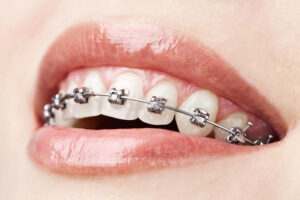What Are Braces?
Braces are dental tools that help correct problems with your teeth, like crowding, crooked teeth, or teeth that are out of alignment. Many people get braces when they’re teenagers, but adults get them too. As you wear them, braces slowly straighten and align your teeth so you have a normal bite. Some people get braces to adjust their smile.
If you have crooked teeth and/or a misaligned bite (an underbite or overbite), there are a variety of treatments that can help straighten teeth, including braces and retainers, custom-made, removable or fixed tools that cover the outside of your teeth and help keep them in position. Learn more about how to tell if you have an overbite.
Types of Braces
Braces are the most popular way to straighten teeth and correct misaligned bites in children. They’re not the shiny mouthful of metal of years past. Many more options are now available.
If braces are indeed the solution for you, the dentist or orthodontist will prescribe an appliance specific for your needs. The braces may consist of bands, wires, and other fixed or removable corrective appliances. No one method works for everyone.
- Metal/traditional braces: Traditional braces are made of metal. They include brackets that are attached to the front of your teeth or bands that fit around each tooth, as well as flexible wires or arch wires that hold the brackets or bands together. Some braces also include rubber bands or metal ties that link the brackets to the wire. These bands create more pressure to help straighten and align your teeth. Sometimes, your orthodontist will have you wear a device called headgear at night. It provides added pressure to help straighten your teeth. You can put it on and take it off.
- Ceramic braces: The brackets in traditional braces are now also made in tooth-colored ceramic, so you don’t notice them as much. They can also be made with stainless steel, clear materials, or gold.
- Lingual braces: The brackets on these braces are attached to the backs of your teeth, facing your tongue. Lingual braces are harder to see.

How Long Will I Have to Wear Braces?
The time required for braces varies from person to person. It depends on:
- How severe your problem is
- The amount of room inside your mouth
- The distance your teeth must travel
- The health of the teeth, gums, and supporting bone
- How closely you follow instructions
On average, once braces go on, they usually remain in place for 1 to 3 years. After braces come off, most people need to wear a retainer all the time for the first 6 months. After that, you have to wear it only while you’re asleep, but you may do it for many years.
Braces Treatment
The orthodontist will want to see you about every month or so in order to make sure the braces are putting steady pressure on your teeth. They’ll adjust the wires, springs, or rubber bands to create more tension and pressure. In some cases, braces alone won’t be enough to straighten your teeth or shift your jaw. That’s when the orthodontist will suggest headgear.
Will Braces Be Painful?
There may be some discomfort when braces are put on, when they are adjusted, or when you start using a new appliance, such as rubber bands or headgear.
Over-the-counter pain relievers like acetaminophen or ibuprofen can help. Tell your orthodontist if you have a lot of pain after each adjustment. They may be able to make the adjustments a bit differently or provide special wax to cover the sharp areas on the braces.
Can You Be Allergic to Braces?
Some people are allergic to certain metals, such as nickel. When this happens, other materials can be used instead. People can also be allergic to the latex gloves used by the orthodontist and the assistants.
Braces can sometimes irritate gums, causing swelling. This is not an allergic reaction but is still something to watch for.
What Foods Are Off-Limits With Braces?
Braces are delicate. Breaking part of the appliance can result in the teeth moving in the wrong direction and in longer treatment. Avoid anything that is hard, sticky, or chewy, including:
- Ice
- Nuts
- Popcorn
- Hard candy
- Chewing gum
- Chewy candy, like caramel
- Gummies
- Hard or tough-to-bite foods, such as apples or bagels
- Corn on the cob
- Hard pretzels
- Carrots